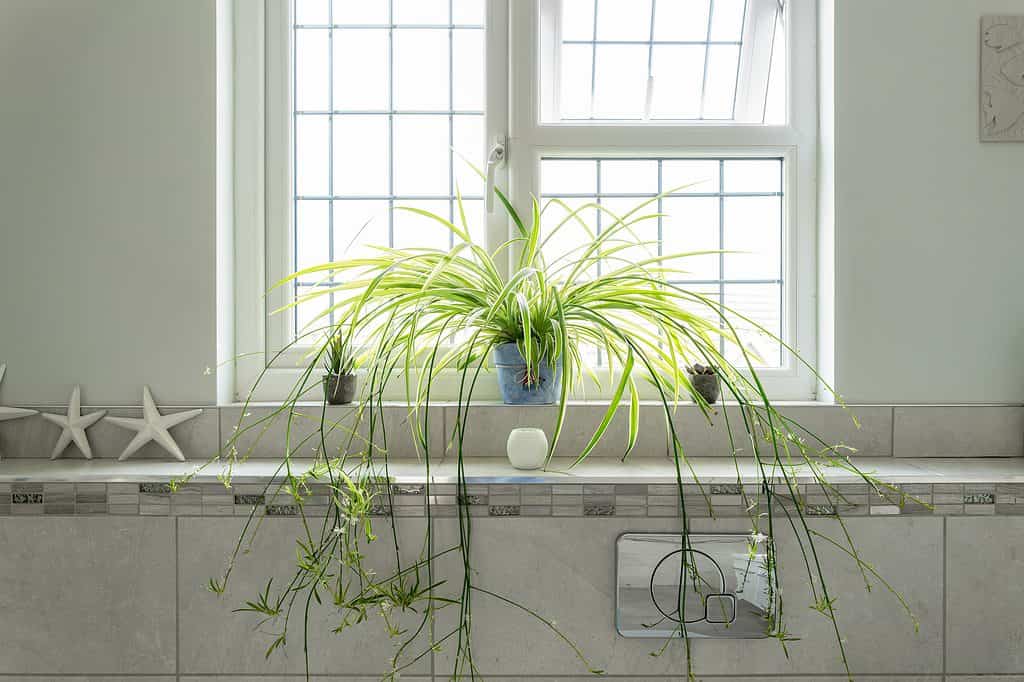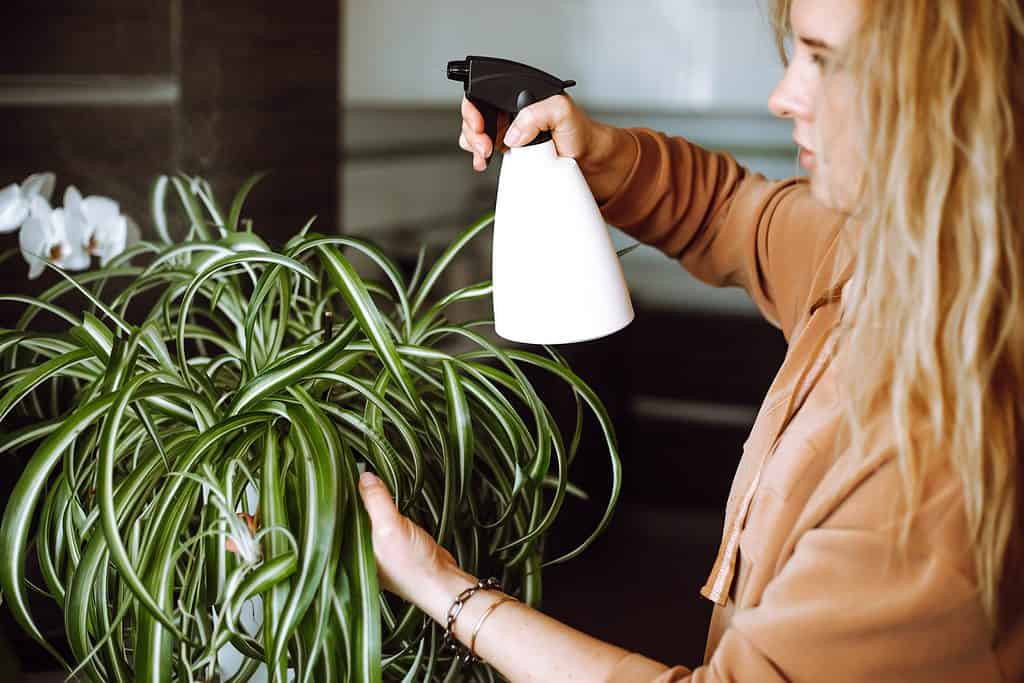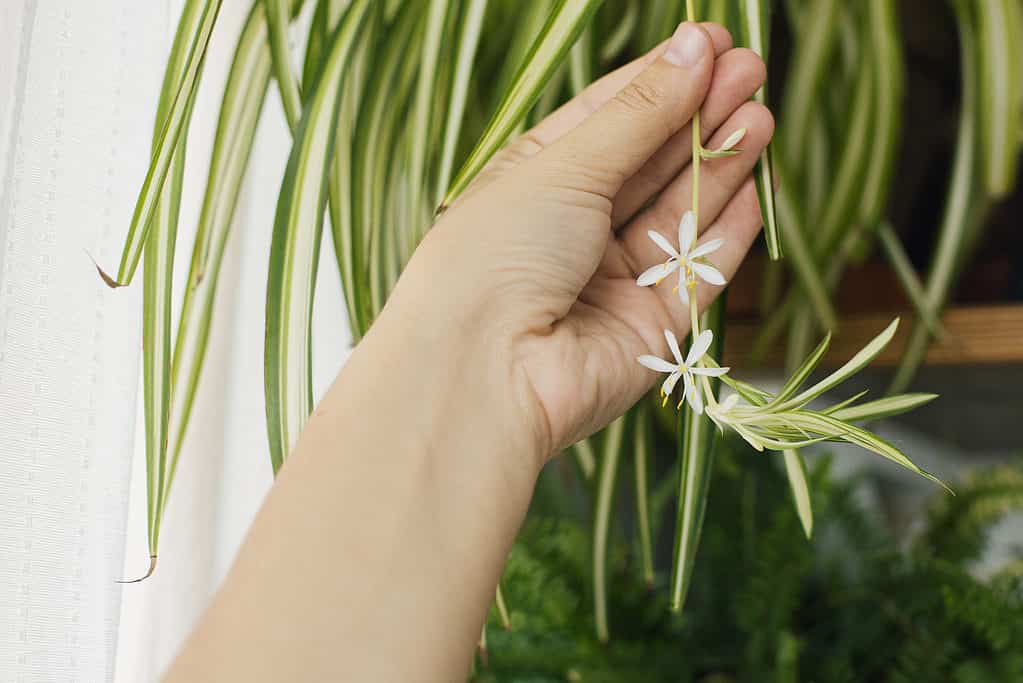The spider plant, also known as Chlorophytum comosum, is regarded as one of the simplest and most adaptable indoor plants. Apart from brown tips and pest issues, this plant may thrive in various environments and has a few other issues. Because of its spider-like babies, known as spiderettes, which hang down from the mother plant like spiders on a web, the spider plant earned its common name. These spiderettes, which come in green or variegated forms, frequently begin their lives as tiny white blooms. That’s right; your spider plant can grow flowers!
Caring for spider plants indoors is easy. These hardy indoor plants can withstand much damage, making them ideal for amateur gardeners or people who lack a green thumb. They will thrive if you give them soil that drains well and bright, indirect light. Water the plants well, but avoid drowning them in water, which can cause root rot. Actually, between waterings, spider plants prefer to dry out a little. When it comes to the basics, that’s all you really need to do to keep your spider plant alive. However, you can take some other steps to ensure it will thrive instead of just surviving indoors.
In this guide, we’ll break down everything you need to know to grow your very own spider plant indoors. We’ll cover everything from watering to light requirements to the soil to maintenance.
Spider Plant: Key Characteristics
The spider plant is classified as Chlorophytum comosum and is part of the Asparagaceae family. There are many varieties of spider plants, but most of them have very similar characteristics. Spider plants are herbaceous perennials that can reach two feet tall and two feet wide, though they can occasionally grow larger.
These plants require partial sunlight or dappled shade, bright and indirect light, loamy, well-draining soil, and a neutral soil pH. These plants flower regularly, and those little white flowers turn into spiderettes that can be pruned off and propagated into new spider plants. The spider plant thrives outside in USDA hardiness zones nine through 11, though it is native to central and southern Africa.

Spider plants (pictured) can grow very large if plants near bright, indirect light from a window.
©Nick Beer/Shutterstock.com
Where to Grow Spider Plants Indoors
Indoors, grow spider plants in light that is indirect but bright. The majority of varieties can withstand somewhat low light levels. However, more light will cause plants to develop more quickly. Avoid direct sunlight since it might burn the leaves of this plant.
Due to their fountain-like habit of growing and trailing plantlets, spider plants are ideal for growing in hanging baskets. Choose a container that is no bigger than one-third the size of your plant’s root ball. Fill the container one-third of the way with an indoor potting mix that drains properly. Coconut coir, sand, or perlite should be included in the mixture because they can store and release water, assisting in soil drainage and preserving an equal moisture level.
The top of the root ball should be about one inch below the container’s top when the plant is placed inside. As a result, there will be room to water the plant without worrying about the water spilling over the pot’s sides. Around the root ball, fill in more soil. After giving the plant plenty of water and allowing it to drain, transport it to its permanent spot inside the home.
Spider Plants: Sunlight Requirements
For spider plants, direct sunshine is too harsh, especially during the summer. The leaves will get droopy and develop unsightly brown blotches or sunburns from too much sun. They prefer full to partial shade outdoors or bright, indirect sunshine indoors. They do, however, require a lot of light in order to blossom and generate offspring. Therefore, if yours won’t flower or grow spiderettes, it’s likely that it’s receiving too much shadow and not enough sun. Use a grow light indoors or move it to a brighter area if this is the case.
Spider Plants: Water Requirements:
Successful spider plant maintenance includes effective watering. They prefer constant wetness but dislike being overwatered. Never subject your plant to stress by constantly letting it dry completely out. The leaves will wilt and turn brown in very dry soil. It’s time to give them more water after the top inch of the soil has dried. You can always give yours the right quantity of water with the aid of a moisture gauge. They are also sensitive to the salts and toxins contained in tap water, which is another crucial point to keep in mind. Therefore, the easiest way to avoid issues is to use distilled, filtered, or rainwater.

Regular misting can improve the humidity needed by your spider plant (pictured).
©tativophotos/Shutterstock.com
Spider Plants: Humidity and Temperature Requirements
High humidity is ideal for Chlorophytum comosum growth, which is why they enjoy growing outside in the summer in tropical places. The same humidity requirements should apply indoors. They dislike excessively dry air, which can lead to various issues and is particularly problematic indoors during the winter. Your plant will look wonderful indoors all year long with regular misting of its leaves or the nearby operation of a humidifier.
Between 60 and 90 degrees F is the best temperature range for growing spider plants. They can endure colder temperatures, but if the temperature falls persistently below 50 degrees F, they will start to suffer. If it falls below 30 degrees F, spider plants will likely die pretty quickly. They often don’t mind the heat, but the cold can be a death sentence for these plants.
Spider Plants: Soil and Fertilizer Requirements
You don’t need to worry too much about selecting the perfect type of soil for growing spider plants. They don’t require a specific blend and aren’t very picky. As previously noted, they thrive in well-draining potting soil, especially when sand, coconut coir, or perlite are added. However, they flourish best in a nutrient-rich media and do need excellent drainage. So be sure to invest in a premium potting mix for them. You can easily mix your spider plant soil by mixing two parts peat moss or coconut coir, one part pumice or perlite, and a quarter part vermiculite.
Fertilizer is not necessary for spider plants because they don’t use large amounts of food. Of course, feeding them does assist them and helps them thrive. They are, however, delicate to chemicals. They are readily burned by synthetic fertilizers and will sometimes suffer from dark leaf tips when chemical fertilizers are used. Therefore, we strongly advise utilizing organic alternatives.
Start in the early spring to encourage healthy new growth for the summer. Feed them a liquid compost tea or a general-purpose tea once a month. Alternately, top-dress a few times throughout the course of the summer using slow-release granules. Fall is the time to slow down fertilizing, and winter is the time to stop feeding them completely.
Do I Need to Repot My Spider Plant?
Spider plants can soon become root-bound because they grow so quickly. However, they may live in their pot for a very long period and prefer it. But if you wait too long, their condition will deteriorate. Because of this, many people incorporate repotting into their normal spider plant care regimen. Spring is the ideal season to size them up. Ensure the container has drainage holes and is larger than the present one.
What to Do With Spiderettes
If you’ve taken very good care of your spider plant, you will begin to see spiderettes. This is a good thing! However, if you don’t like the look of them, you can prune them off and use them for propagation quite easily.
In the spring, as the amount of sunshine increases, spider plants should start to produce blossoms, ultimately giving birth to spider plant spiderettes. However, as only mature plants with sufficient energy reserves would generate spiderettes, this might not always happen. Spiderettes can be cut off and seeded in soil or water, although planting them in soil often produces better results and a stronger root system.
Ideally, leaving the plantlet connected to the mother plant is the best way to root spider plant spiderettes. Select a spiderette and set it in a soil-filled container next to the mother plant. Once it has rooted, remove it from the mother plant and continue to water it well.
Alternatively, you could simply remove one of the plantlets, put it in a soil-filled container, and give it lots of water. Put the pot in a plastic bag with ventilation and place it somewhere that is well-lit. When the spiderette has a strong root system, take it from the bag and continue to care for it until it develops into a full plant.

If you don’t like the look of spider plant flowers (pictured), you can easily remove them and any damaged leaves.
©iStock.com/Bogdan Kurylo
Should I Prune My Indoor Spider Plant?
By pruning, spider plants can easily be kept at a more aesthetically pleasing and controllable size. Pruning can also improve the health of your plant. Just as well, when the spider plant puts out a lot of energy when producing spiderettes, it requires more fertilizer and water. Thus, you might want to prune off your spiderettes, even if you don’t plan to propagate them.
Any leaves that must be chopped should be taken from the plant’s base. When pruning down spider plants, ensure that you always use clean, sharp, and sturdy scissors. As your plant requires it, remove all dead, diseased, infested, yellowish, or brownish leaves. Cut the long stems from the mother and young plants back to the base to eliminate spiderettes.
Common Indoor Spider Plant Problems and Solutions
There is no need for concern if you start to detect browning spider plant leaves. The natural occurrence of browning leaf tips won’t harm the plant. Fluoride, which is present in water and contributes to salt accumulation in the soil, is frequently to blame for this browning. It normally helps to give spider plants a good watering on a regular basis to drain off extra salts in the soil. Make careful to let the water drain completely before watering again, if necessary. Additionally, using distilled water or even collected rainwater on plants as opposed to water from the kitchen or an outside spigot may be beneficial.
Regular maintenance is the greatest way to prevent an infestation of pests on spider plants, even though pest problems tend to be quite rare for these beauties. But occasionally indoors, mealybugs, whiteflies, spider mites, or scale might become an issue. Use an organic pesticide soap to wash away any bugs you find gently. You may also create your own pesticide by combining one quart of water and one teaspoon of mild organic liquid soap. Additionally, neem oil is excellent in killing pests and preventing their re-emergence.
The spider plant makes an excellent houseplant for both the novice plant parent and the experienced houseplant pro. It’s easy to care for, looks gorgeous, and is non-toxic to children and plants. There’s quite a bit to love about the spider plant!
Are Spider Plants Bad Feng Shui?

Spider plants are thought to bring good fortune, positive energy, and fertility.
©ArtCreationsDesignPhoto/Shutterstock.com
Like many plants, there may be some pros and cons of keeping a spider plant, although if you are not very good with keeping your greens healthy, this is one of the more hearty plants that can tolerate being neglected. There is currently some debate as to whether they may be toxic to pets, and while they may be thought to contain a mild hallucinogen, there are no known instances on record that show toxicity.
Spider plants (Chlorophytum comosum) are, however, thought to be lucky and it is believed that if you have one, you will encounter good fortune, positive energy, and fertility. This easy-to-care-for plant has vines and leaves that symbolize stability in life as they are naturally strong and tiny white flowers are a symbol of purity. If you wish to contribute to a positive feng shui environment, this plant is a great option for your home.
Do you want to learn even more about the incredible and resilient spider plant? Take a look at our complete guide to spider plants here!
The photo featured at the top of this post is © ArtCreationsDesignPhoto/Shutterstock.com
Sources
- NCSU Staff, Available here: https://plants.ces.ncsu.edu/plants/chlorophytum-comosum/
- Susan Mahr, Available here: https://hort.extension.wisc.edu/articles/spider-plant-chlorophytum-comosum/
- Jon Vanzile, Available here: https://www.thespruce.com/spider-plants-chlorophytum-definition-1902773
FAQs (Frequently Asked Questions)
Are spider plants good indoor plants?
Yes! Spider plants do well in room-temperature environments and will grow quite large if properly cared for indoors.
Does an indoor spider plant need a lot of sun?
Indoor potted spider plants will benefit from up to eight hours of natural, bright, indirect sunlight from a window each day.
How should I water my potted spider plant?
An indoor potted spider plant will do well with bottom watering, misting, and regular spout watering.
Thank you for reading! Have some feedback for us? Contact the AZ Animals editorial team.






